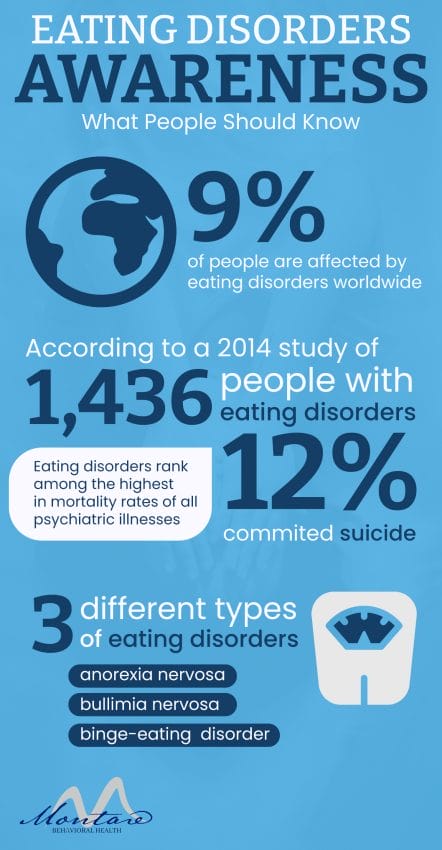Eating disorders such as anorexia, bulimia, and binge-eating disorder are serious, life-threatening conditions that affect people and their families every day.
Did you know that in the United States, approximately 30 million Americans will suffer from some type of eating disorder in their lifetime, which has the highest death rate of any mental illness? Yet, only one-third of individuals suffering do so in silence and choose to never receive treatment.
Unfortunately, it can sometimes be challenging to receive an accurate diagnosis of an eating disorder. This is because the symptoms that occur do not always present themselves the same. These deadly diseases don’t discriminate, and therefore, sufferers could be of any age, gender, ethnicity, sexual orientation, socioeconomic status, and have any body type.
Like any other type of mental health disorder, eating disorders are treatable. Most people who suffer from one do recover, but the key to success and long-term results is early identification and intervention before things take a turn for the worse.
February is National Eating Disorder Awareness Month. Below are some information and resources that you might find helpful if you feel that you or a family member may be struggling with an eating disorder.
Our guide explains what eating disorders are, how to spot the signs, the impact they have, what treatments are available for those who suffer, and how to help raise awareness.
Spread the Word, Save A Life: Eating Disorder Awareness
Anorexia nervosa, bulimia nervosa, and binge-eating disorders are some of the most common eating disorders, but there are also other types of disordered eating that people may not be as knowledgeable about. That is why The National Eating Disorders Association (NEDA,) along with other organizations, are bringing attention to National Eating Disorders Awareness Week.
The Goal Of National Eating Disorder Awareness Week
National Eating Disorders Awareness Week was developed with a mission to reduce stigma from mental illness, and most importantly, to help educate and spread awareness. Other goals include providing better access to mental health care and resources for those suffering or who know someone who is from an eating disorder.
As mentioned before, eating disorders have the highest mortality rate of any other type of mental disorder. Therefore, it’s important to try and dispel any sort of misinformation, so that the increased demand for needing help matches the number of people who are receiving it.
At Montare Behavioral Healthcare, our team prides ourselves on working in tandem with organizations such as NEDA, that support the importance of mental health. You can join us in raising awareness through social media, advocacy, local events, and more.
Understanding Eating Disorders
It’s important to understand eating disorders are mental illnesses that can be managed with professional help. If left untreated, the result can be deadly. Often misunderstood or misdiagnosed, sometimes signs and symptoms are evident. Other times the person who is suffering has already done so enough due to not receiving the treatment and care they so desperately need.
These mental conditions are much more common in women than men. Women in their teens are most likely to develop an eating disorder, but men are also affected, even though it is a common misconception that they aren’t
What Are Eating Disorders?
Eating disorders result from disordered eating and manifest always surrounding the issue of food. These illnesses can occur during childhood or adolescence/teenage years, but it is rarer that they develop when in adulthood.
According to Mayo Clinic, eating disorders are serious, potentially deadly conditions related to behaviors surrounding eating. However, these issues negatively impact all aspects of someone’s life, including their physical and emotional health, and ability to function in other areas of life.
Much like a person with Obsessive-Compulsive Disorder (OCD), when a person has symptoms of an eating disorder, he or she presents signs of compulsive behavior with weight, food, and exercise. The obsession with body image, focusing too much on body shape and food intake, leads to dangerous eating habits and behaviors.
This majorly affects the body’s ability to receive the appropriate amount of nutrition to function properly. Eating disorders cause mild to severe health complications, including problems with the heart, digestive system, bones, and teeth, and mouth, and can lead to other diseases.
The good news is, with treatment and proper access to mental health care, specialists can help people learn how to cope with their conditions, proper nutrition, and eating habits. They also learn tips on how to love their bodies and increase self-esteem, which can possibly reverse serious complications caused by the eating disorder.
Types of Eating Disorders: The Main 3
The most common types of eating disorders are anorexia nervosa, bulimia nervosa, and binge-eating disorder (BED). There are other types of eating disorders that are not specified in the DSM, often known as EDNOS. These include eating disorders that don’t fit into the category as these three common ones.
1. Anorexia Nervosa
Anorexia nervosa or “anorexia” is probably the most common type of eating disorder characterized by extremely low body weight, intense fear of gaining weight or eating calories, a distorted perception of one’s body image, weight, or shape.
People with anorexia need to control the amount of food they eat, their weight, and their appearance, by excessively limiting calories or other methods to keep weight off, such as excessive exercise, laxatives, or vomiting after eating. Already causing people to be extremely underweight, anorexia significantly affects daily functioning, health, and overall life. Due to starvation, organ failure, and other severe health problems, death can occur if left untreated.
2. Bulimia Nervosa
Bulimia nervosa or “Bulimia” is a serious and potentially life-threatening type of eating disorder. When someone is diagnosed with bulimia, they exhibit the characteristics opposite of anorexia in terms of food. People have episodes where they binge or eat large amounts of food in a short amount of time, and in their mind, to not gain weight they try to rid the extra calories by purging or throwing up what they ate.
This unhealthy habit of eating and purging also often occurs due to the stigma (feelings of guilt and shame) and an intense fear of weight gain from overeating. They also use methods such as excessive exercise and laxatives to support their compulsive thoughts.
Similar to anorexia, people with bulimia have a preoccupation with their weight and body image. It’s important to note that people with bulimia nervosa do not typically look underweight or maybe at a normal weight or even a bit overweight.
3. Binge-Eating Disorder
Binge-Eating Disorder is one of the most common types of eating disorders, classified as a person who experiences a lack of control over their eating. It is characterized by eating an excessive amount of food quickly, typically in one sitting. Usually, many calories are consumed, maybe more than intended.
People with BED may keep eating even when they are not hungry or full. Feelings of guilt and shame often accompany individuals after binging. As people with anorexia and bulimia would exercise or purge their food, individuals suffering from binge-eating disorder often hide during their episodes. This often occurs at least once a week or more.
The good news is, with treatment and proper access to mental health care, specialists can help people learn how to cope with these life-threatening conditions.
Signs and Symptoms of An Eating Disorder
The most common symptoms of eating disorders include either excessive overeating, sometimes including binge eating and then purging, or severe restriction of calories. A major sign that someone is suffering from something more severe such as an eating disorder is having an obsession with eating and food, as well as weight and body image. This leads to significant distress, and these mental conditions often co-occur with other conditions, such as depression, anxiety, and trauma.
Signs and symptoms of an eating disorder can sometimes be hard to identify or distinguish, as they can often present themselves very similarly. The impacts of an eating disorder can be both immediate and long-term. This is especially true in the early stage of one of these conditions.
Over time, an eating disorder will become more difficult to hide due to extreme weight loss or gain at alarming rates. Here are signs and symptoms to help identify and recognize if their loved one has a potential eating disorder.
Short-Term Symptoms
- Constant sore throat / acid reflux
- Unusual fatigue or lethargy
- Tooth decay and/or erosion
- Dehydration
- Frequent bathroom trips after meals, purging, unusual use of diuretics and/or laxatives
- Calluses or scars on hands and wrists
- Extreme and rapid weight loss
- Refusing to eat normal amounts of food or avoiding it altogether
- Refusing to eat in front of other people
- Withdrawal from friends and activities
- Growth of fine hair over entire body or hair loss
- Worry over gaining the slightest amount of weight
- Excessive exercise
- Absence of menstrual cycle/period (amenorrhea)
Long-term Symptoms
- Anemia
- Ulcers
- Kidney failure
- Infertility
- Diabetes
- Osteoporosis
- Organ failure
- Severe constipation
- Brittle hair or fingernails
- Dry or yellowing skin
- Brain damage
The impact of an eating disorder can be both short-term and long-term, but, the emotional and psychological impact can be devastating and deadly. Research shows that those who have anorexia are 18 times more likely to die 18 times than those without an eating disorder.
Eating Disorders and Their Effect on Body Image

Body image is defined as having inner thoughts and feelings about one’s physical appearance. For example, how someone views themselves and their body (height, shape, and weight). Curiosity and opinions about anatomy begin at a young age. For girls to express concerns about their weight or how they perceive themselves starts at 6 years old. Sadly, 40-60% of elementary school girls (ages 6-12) are concerned about their weight or about becoming fat or overweight.
It is important to note that the age of self-reflection and body concerns differs depending on the individual. Over half of teenage girls and boys use unhealthy methods of controlling their weight, such as skipping meals, taking laxatives, smoking, fasting, and vomiting up their food.
In a perfect world, everyone would have a positive body image, which would be loving your shape/body as they are, and feeling confident in your skin. However, those with eating disorders have nothing but a negative body image, which results in a distorted perception than what everyone else views of them.
To put it simply, people with these mental disorders, feel that they look way more flawed in comparison to others. As a result, this body dissatisfaction, low self-esteem, and low self-confidence results in feelings of depression, loneliness/isolation, shame, anxiety, and self-consciousness. Thus, triggering negative eating habits and behaviors.
In today’s society, there are major pressures to look and feel a certain way. While there is a level of acceptance, girls and boys often feel this phenomenon of the societal appearance-ideal. This is sometimes referred to as the thin, beautiful, or cultural-ideal.
Eating disorder awareness week aims to discuss the importance of body positivity. Embracing and accepting diversity by recognizing all bodies as good bodies no matter the shape, color of skin, age, etc. Here at Montare Behavioral Health, we teach our clients with eating disorders to learn how to overpower their negative thoughts and feelings with positive, affirming, and accepting ones.
Disordered Eating vs Eating Disorder
There is a difference between disordered eating, dieting, and having an eating disorder. There is nothing worse than not knowing what is wrong with you, or how to help a loved one. But, knowing how to distinguish the three can be extremely helpful in learning the steps to do so.
To explain it in simple terms, whether someone is dieting, has disordered eating, or an eating disorder, it is defined based on how someone controls how or the way they eat, and their motivations behind their behavior.
Disordered eating is characterized by having unusual or abnormal eating patterns. However, it does not meet the definition or criteria to classify or warrant it as an actual eating disorder. In other words, someone who suffers from disordered eating may have certain symptoms or habits of what would consider it to be an eating disorder, such as compulsive eating, purging (throwing up food), and binge eating. However, someone with disordered eating doesn’t do these things as severely as someone diagnosed with an eating disorder.
What’s the Difference Between a Diet and an Eating Disorder?
A diet is eating in a regulated and modified manner to lose weight or become healthier. Dieting has specific goals in mind, such as losing 10 pounds before summer to fit into your favorite bikini. While on a diet there are generally no exhibiting compulsive behaviors. There may be a strict plan to follow such as what foods to eat and not eat, and counting calories, but, in a more reasonable fashion.
Dieting is a more universally accepted and sometimes beneficial activity, while disordered eating can develop into an eating disorder, which is extreme. For example, a person on a diet will substitute more fruits and vegetables for a cheeseburger, whereas, individuals with an eating disorder will either skip meals entirely or eat and purge their food.
Lastly, a big difference between dieting and having an eating disorder is the motivation and reasoning behind a person’s eating behavior, why, and how. For example, someone who is on a diet sets a goal to lose weight, and once that goal is reached, they either stop their bad eating habits and continue a healthy lifestyle or return to old ways. Dieting can be a yo-yo cycle where people relapse after losing weight and gain it all back.
Eating Disorder Statistics
Here are some statistics of eating disorders by the National Association of Anorexia Nervosa and Associated Disorders (ANAD), to help demonstrate how prevalent these potentially-deadly mental conditions truly are.
- Due to eating disorders each year, 10,200 deaths occur as a result. That’s one death every 52 minutes.
- Eating disorders are among the deadliest mental illnesses, second only to opioid overdose.
- About 26% of people with eating disorders attempt suicide.
- The cost of people with eating disorders is $64.7 billion every year.
- The risk for developing an eating disorder due to genetics is 28-74%.
Organizations That Support Eating Disorder Awareness Week
Many organizations are working in the areas of awareness, support, advocacy, referral, education, and prevention of eating disorders. Here are some of the best resources to use for research and furthering your education about eating disorders and how to help spread the word.
- The National Association of Anorexia Nervosa and Associated Disorders (ANAD): The National Association of Anorexia Nervosa and Associated Disorders, (ANAD), is the oldest non-profit organization focused on fighting eating disorders in the United States. They are a major source of support for people struggling with eating disorders and also provide resources for families, schools, and the eating disorder community.
- The National Eating Disorders Association (NEDA): The largest nonprofit organization dedicated to supporting individuals and families affected by eating disorders.
- The Alliance: The Alliance for Eating Disorders Awareness is a national nonprofit organization dedicated to the support and advocacy for all eating disorders, including outreach, education, and early intervention.
What Can Loved Ones Do to Help Educate About Eating Disorders?
Friends and family are also just as affected as their loved ones suffering from an eating disorder. To help be an advocate, one can help by educating people about the facts, and what you do know.
There are many resources available to help people become better equipped to know how to use the proper tools to effectively cope with these conditions. Knowledge is power. We can all benefit from more awareness brought to an important cause. In return, we can better the chances of detecting more accurate diagnoses of eating disorders and reduce the mortality rate of mental illnesses.
We Can Help You Recover and Fight For Eating Disorder Awareness
If you or a loved one is suffering from an eating disorder, our team of highly trained and skilled mental health specialists can help you recover and learn to manage your condition. Know you’re not alone! To learn more about eating disorders awareness week, and we can help you fight or join the fight, contact us today!
References
https://anad.org/get-informed/about-eating-disorders/eating-disorders-statistics/
https://www.learnpsychology.org/mental-health/eating-disorders/
https://www.nationaleatingdisorders.org/about-us
https://www.allianceforeatingdisorders.com/eating-disorders-awareness-week-2021/
https://www.nationaleatingdisorders.org/body-image-eating-disorders







